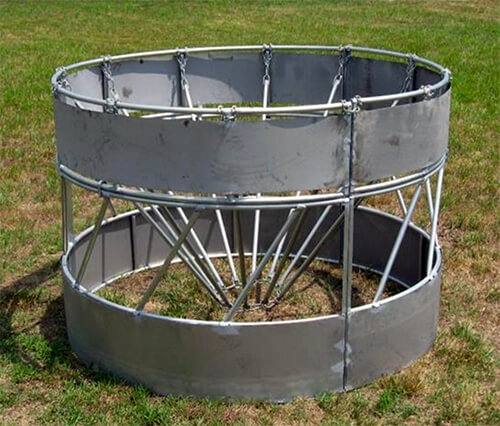Save hay by choosing the right type of feeder
Oct 07, 2019

Hay feeders have become an important part of any cattle farm. Increased costs of producing hay have made it a valuable commodity. Fuel and equipment costs make today’s farmer look very closely at getting the most out of every bale fed.
While some waste will occur no matter what, protecting hay from animal activity will reduce that waste. A university study calculated waste from four different types: a cone feeder, a standard hay ring, a feeder wagon, and a hay cradle. On average, the cone feeder had 3.5 percent waste, the hay ring 6.1 percent, the wagon 11.4 percent, and the cradle 14.6 percent. These numbers speak for themselves.
However, those waste percentages are minimal compared to the 18 percent to 20 percent loss that can occur when you feed hay loose on the ground.
Here is a closer look at the various types of feeders available at your local Co-op:
• Cone feeders, like the Co-op Hay Saver (#156481), suspend hay off the ground, allowing cattle more room to keep their heads inside the feeder while eating. These feeders have also shown to reduce the amount of wasted hay as compared to traditional hay rings.
• Hay rings allow cattle to feed without wasting hay by trampling or bedding in it. We suggest you try the Co-op Super Heavy-Duty Hay Ring (#15641), the skirted version (#15648) that further protects hay from waste, or our standard Co-op Hay Ring (#15638).
• Feeder wagons can hold from one to four round bales and allow hay to be moved easily to different locations. Your Co-op offers several types of these, such as the Pequea Hay Feeder Wagon (#300627) or Apache Feeder Wagons (#27510 or #27513).
A feeder with slanted bars encourages cattle to keep their heads inside, which also keeps the hay inside where it can’t be trampled and wasted. Cone feeders or standard hay rings also allow cattle to feed in a more natural position, with their heads down. Cattle that have to reach upward or feed from an unnatural position are more likely to throw their heads and toss hay while eating.
The number of cattle and how frequently hay needs to be fed are also factors in choosing the right feeder. It’s always best to have a little more capacity for an increase in cattle numbers. If all the cattle can eat comfortably at the same time, they will be less agitated, waste less, and consume what they need for better health and gains.
No two cattle operations are the same. The Co-op system is fortunate to have access to many livestock specialists who can help analyze your situation so you get the most out of what you put into your livestock.
While some waste will occur no matter what, protecting hay from animal activity will reduce that waste. A university study calculated waste from four different types: a cone feeder, a standard hay ring, a feeder wagon, and a hay cradle. On average, the cone feeder had 3.5 percent waste, the hay ring 6.1 percent, the wagon 11.4 percent, and the cradle 14.6 percent. These numbers speak for themselves.
However, those waste percentages are minimal compared to the 18 percent to 20 percent loss that can occur when you feed hay loose on the ground.
Here is a closer look at the various types of feeders available at your local Co-op:
• Cone feeders, like the Co-op Hay Saver (#156481), suspend hay off the ground, allowing cattle more room to keep their heads inside the feeder while eating. These feeders have also shown to reduce the amount of wasted hay as compared to traditional hay rings.
• Hay rings allow cattle to feed without wasting hay by trampling or bedding in it. We suggest you try the Co-op Super Heavy-Duty Hay Ring (#15641), the skirted version (#15648) that further protects hay from waste, or our standard Co-op Hay Ring (#15638).
• Feeder wagons can hold from one to four round bales and allow hay to be moved easily to different locations. Your Co-op offers several types of these, such as the Pequea Hay Feeder Wagon (#300627) or Apache Feeder Wagons (#27510 or #27513).
A feeder with slanted bars encourages cattle to keep their heads inside, which also keeps the hay inside where it can’t be trampled and wasted. Cone feeders or standard hay rings also allow cattle to feed in a more natural position, with their heads down. Cattle that have to reach upward or feed from an unnatural position are more likely to throw their heads and toss hay while eating.
The number of cattle and how frequently hay needs to be fed are also factors in choosing the right feeder. It’s always best to have a little more capacity for an increase in cattle numbers. If all the cattle can eat comfortably at the same time, they will be less agitated, waste less, and consume what they need for better health and gains.
No two cattle operations are the same. The Co-op system is fortunate to have access to many livestock specialists who can help analyze your situation so you get the most out of what you put into your livestock.